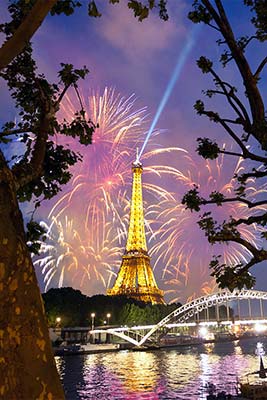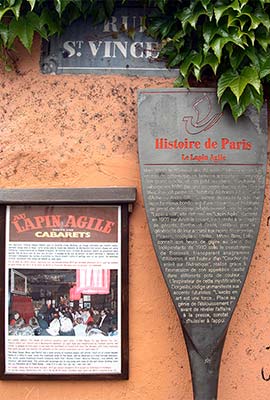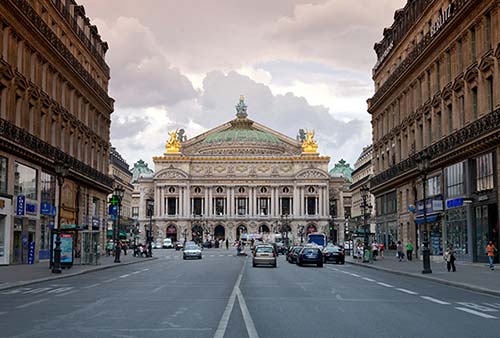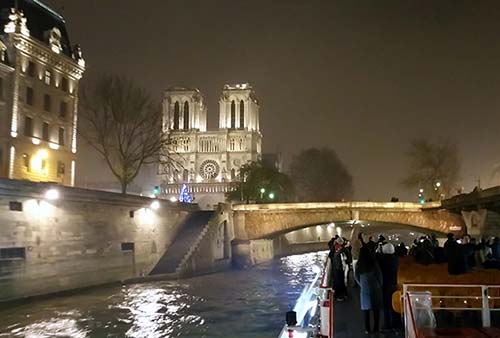
▲▲Champs-Elysées and the Arc de Triomphe
▲▲Ile St. Louis and Notre-Dame
Place de la Concorde, Place Vendôme, and Place de l’Opéra
Place St. Germain-des-Prés and Odéon
▲▲▲Floodlit Paris Driving Tour by Taxi or Uber
Map: Floodlit Paris Driving Tour
Paris is brilliant after dark. Save energy from your day’s sightseeing and experience the City of Light lit. Whether it’s a concert at Sainte-Chapelle, a boat ride on the Seine, a walk in Montmartre, a hike up the Arc de Triomphe, or a late-night café, you’ll see Paris at its best. Night strolls in Paris are wonderful. Any of the self-guided walking tours in this book are terrific after dark. And our DIY taxi/Uber tour of floodlit Paris is a sure memory of a lifetime.
The best single guide is L’Officiel des Spectacles (comes out in print on Wed, www.offi.fr). The magazine/website offers a complete weekly listing of music, cinema, theater, opera, and other special events. The order of the contents changes periodically, but the basics described below are always there...somewhere. Your translation app can help you make sense of it.
“Théâtre” describes what’s playing at all key theater venues. “Cinéma” marks films as “Comédie,” “Documentaire,” “Drame,” “Karaté,” “Erotisme,” and so on. The key mark for non-French speakers is “VO,” for version originale (original-language version)—this means the movie hasn’t been dubbed in French. Films are listed alphabetically, by neighborhood (“Salles Paris”), and by genre. To find a showing near your hotel, simply look for a cinema in the same arrondissement (banlieue means the cinema is in the suburbs). Many cinemas offer discounts on Monday or Wednesday nights.
“Concerts” lists each day’s performances, from jazz to classical to dance. This section also includes both opera houses if performances are scheduled. Some concerts are free (entrée libre).
The “Enfants” section covers children’s activities, from musicals to treasure hunts. Look for “Spectacles” (events such as magic shows), “Marionnettes” (puppet shows), and “Cirques” (circuses). These events usually are offered only in French, but they can be worthwhile even for non-French speakers.
“Expositions” lists the hours of Paris’ many museums alphabetically and by type—Beaux-Arts, Contemporain, Photographie, Histoire, Sciences, etc. (tlj = daily, sf = except, Ent = entry price, TR = reduced price—usually for students and children). Also provided are hours and locations for gallery showings (big and small). Type “musées” in the search bar to find this info.
Online English Sources: If you want event information in English, the Paris Voice website has helpful reviews of art shows, entertainment, and more (www.parisvoice.com). Find timely articles on museum exhibitions, holiday happenings, and other topics at ColleensParis.com. Time Out’s English website is another good resource, with listings for the city’s most talked-about restaurants, reviews of concerts and stores, and ideas for how to enjoy Paris’ nightlife and shopping on a budget (www.timeout.fr/paris/en).
With a lively mix of American, French, and international musicians, Paris is an internationally acclaimed jazz capital. You’ll pay €12-25 to enter a jazz club (may include one drink; if not, expect to pay €5-10 per drink; beer is cheapest). See L’Officiel des Spectacles under “Concerts” for listings, or, even better, the Paris Voice website noted in the last section. You can also check each club’s website (all have English versions) or drop by the clubs to check out the calendars posted on their front doors. Music starts after 21:00 in most clubs. Some offer dinner concerts from about 20:30 on. Here are several good bets:
Caveau de la Huchette, a fun, characteristic old jazz/dance club, fills an ancient Latin Quarter cellar with live jazz and frenzied dancing every night (admission about €16, €10 for those under 25, drinks from €7.50, daily from 21:00, no reservations needed, buy tickets at the door, 5 Rue de la Huchette, Mo: St-Michel, +33 1 43 26 65 05, www.caveaudelahuchette.fr).
For a spot teeming with late-night activity and jazz, go to the two-block-long Rue des Lombards, at Boulevard Sébastopol, midway between the river and the Pompidou Center (Mo: Châtelet). Au Duc des Lombards is one of the most popular and respected jazz clubs in Paris, with concerts nightly in a great, plush, 110-seat theater-like setting (€25-55, buy online and arrive early for best seats, reasonable drink prices, shows usually at 19:30 and 21:30, 42 Rue des Lombards, +33 1 42 33 22 88, www.ducdeslombards.com). Le Sunside is just a block away. The club offers two little stages (ground floor and downstairs): “Le Sunset” stage tends toward contemporary world jazz; “Le Sunside” stage features more traditional and acoustic jazz (concerts €25-40, a few are free; 60 Rue des Lombards, +33 1 40 26 46 60, www.sunset-sunside.com).
For a less pricey—and less central—concert club, try Utopia in the Montparnasse area. From the outside it’s a hole-in-the-wall, but inside it’s filled with devoted fans of rock and folk blues. Though Utopia is officially a private club (and one that permits smoking), you can pay €3 to join for an evening, then pay a reasonable charge for the concert (usually €12 or less, concerts start about 21:00; 79 Rue de l’Ouest, Mo: Pernety, +33 1 43 22 79 66, www.utopia-cafeconcert.fr).
Au Lapin Agile, a historic little cabaret on Montmartre, tries its best to maintain the atmosphere of the heady days when bohemians would gather here to enjoy wine, song, and sexy jokes. Today, you’ll mix in with a few locals and many tourists (the Japanese love the place) for a drink and as many as 10 different performers—mostly singers with a piano. Performers range from sweet and innocent Amélie types to naughty Maurice Chevalier rogues. And though tourists are welcome, there’s no accommodation for English speakers (except on their website), so non-French speakers will be lost. You sit at carved wooden tables in a dimly lit room, taste the traditional drink (a small brandy with cherries), and are immersed in an old-time Parisian ambience. The soirée covers traditional French standards, love ballads, sea chanteys, and more (€35, €25 for those under 26, €5-9 drinks; Tue and Thu-Sat from 21:00; closed Mon, Wed, and Sun; best to reserve ahead, 22 Rue des Saules, +33 1 46 06 85 87, https://au-lapin-agile.com).

Au Lapin Agile and the overrated and touristy Moulin Rouge nightclub are both described in more detail in the Montmartre Walk chapter.
For classical music on any night, consult L’Officiel des Spectacles magazine (check “Classique” under “Concerts” for listings), and look for posters at tourist-oriented churches. From March through November, these churches regularly host concerts: St. Sulpice, St. Germain-des-Prés, La Madeleine, St. Eustache, St. Julien-le-Pauvre, and Sainte-Chapelle.
Sainte-Chapelle: Enjoy the pleasure of hearing Mozart, Bach, or Vivaldi surrounded by 800 years of stained glass (unheated—bring a sweater). The acoustical quality is surprisingly good. There are usually two concerts per evening, at about 19:00 and 20:30; specify which one you want when you buy or reserve your ticket. Tickets run about €40-50, and the more you pay, the closer you sit, though there isn’t a bad seat in the chapel. Seats are unassigned within each section, so arrive at least 30 minutes early to get through the security line and snare a good view.

You can book online, by phone, or at the box office. Several companies sell tickets online but easiest by far is to buy at www.fnactickets.com (search “Sainte-Chapelle”). The small box office (with schedules and tickets) is to the left of the chapel entrance gate (8 Boulevard du Palais, Mo: Cité), or call +33 1 42 77 65 65 for schedules and reservations. You can leave your message in English—just speak clearly and spell your name. Schedules and tickets are also available at www.euromusicproductions.fr.
Philharmonie de Paris: This dazzling, 2,400-seat concert hall is situated in the Parc de la Villette complex. It hosts world-class artists, from legends of rock and roll to string quartets to international opera stars. Tickets range from €10 to €150, depending on the artist and seats, and are usually hard to come by, so it’s best to buy them in advance (221 Avenue Jean-Jaurès, Mo: Porte de Pantin, +33 1 44 84 44 84, www.philharmoniedeparis.fr).
Other Venues: Look for daytime concerts in parks, such as the Luxembourg Garden. Even the Galeries Lafayette department store offers concerts. Many of these concerts are free (entrée libre), such as the Sunday atelier concert sponsored by the American Church (generally Sept-June at 17:00 but not every week and not in Dec, 65 Quai d’Orsay, Mo: Invalides, RER/Train-C: Pont de l’Alma, +33 1 40 62 05 00, www.acparis.org). The Army Museum offers inexpensive afternoon and evening classical music concerts all year round (for programs—in French only—see www.musee-armee.fr). There are also concerts at the Eiffel Tower (see here) and at the Louvre’s auditorium (schedule posted on French version of website—look for “En ce moment/événements & activités” at www.louvre.fr).
Paris is home to two well-respected opera venues. The Opéra Bastille is the massive modern opera house that dominates Place de la Bastille. Come here for state-of-the-art special effects and modern interpretations of classic ballets and operas. In the spirit of this everyman’s opera, unsold seats are available at a big discount to seniors and students 15 minutes before the show. Standing-room-only tickets for €15 are also sold for some performances (Mo: Bastille).
The Opéra Garnier, Paris’ first opera house, hosts opera and ballet performances. Come here for grand belle époque decor (Mo: Opéra; generally no performances mid-July-mid-Sept). To get tickets for either opera house, it’s easiest to reserve online at www.operadeparis.fr, or call +33 1 71 25 24 23 (office closed Sun). You can also buy tickets in person at their ticket offices (open Mon-Sat: Opéra Bastille 14:30-18:30, Opéra Garnier from 11:30; both also open an hour before show; closed Sun).

The Theatre in Paris group enables Anglophones to enjoy selected Parisian theater productions by providing English-language ticketing and specially created programs with show synopses and theater insight. The company also arranges for English-language comedians, easy-to-read subtitles, and optimal seating at a variety of historic theaters. You’ll get a personal welcome to the event from an English-speaking host (shows Tue-Sun, none on Mon, +33 1 85 08 66 89, schedule at www.theatreinparis.com).
Lost in Frenchlation screens French films with English subtitles; see “Connecting with the Culture” on here.
The Open-Air Cinema at La Villette (Cinéma en Plein Air) is your chance to relax on the grass and see a movie under the stars with happy Parisians. Films, shown in their original language with French subtitles, start at dusk (free, chair rental €7, mid-July-Aug Wed-Sun, inside Parc de la Villette complex—enter through main entrance at Cité des Sciences et de l’Industrie, 30 Rue Corentin-Cariou, Mo: Porte de la Villette, www.villette.com).
Various museums (Orsay, Pompidou, Marmottan, and the Louvre) are open late on different evenings—called visites nocturnes—offering the opportunity for more relaxed, less crowded visits. See the sidebar on here for details and other night-owl attractions.
Versailles Spectacles: An elaborate sound-and-light show (Les Grandes Eaux Nocturnes) takes place in the gardens at Versailles on some Saturday evenings in summer (see here).
Several companies offer cruises after dark as well as dinner cruises on huge glass-domed boats (or open-air decks in summer) with departures along the Seine, including from the Eiffel Tower; see “Lunch and Dinner Cruises” in the Eating in Paris chapter.

Go for an evening walk to best appreciate the City of Light. Break for ice cream, pause at a café, and enjoy the sidewalk entertainers as you join the post-dinner Parisian parade. Use any of this book’s self-guided walking tours as a blueprint. (They’re worth doing twice—once by day with the self-guided tour information and again after dark to enjoy the lively people scene and beautiful lighting.) Consider the following suggestions; most are partial versions of this book’s longer walking tours. Don’t dilly-dally; lights at many major monuments are turned off at midnight.
This is one of Paris’ most spectacular views at night. Take the Métro to the Trocadéro stop and join the party on Place du Trocadéro for a magnificent view of the glowing Eiffel Tower. It’s a festival of hawkers, gawkers, drummers, and entertainers. Walk down the stairs, passing the fountains, then cross the river to the base of the tower, well worth the effort even if you don’t go up.
From the Eiffel Tower you can stroll through the Champ de Mars park past tourists and romantic couples, and take the Métro home (Ecole Militaire stop, across Avenue de la Motte-Picquet from far southeast corner of park). Or there’s a handy RER/Train-C stop (Champ de Mars-Tour Eiffel) two blocks west of the Eiffel Tower on the river.
The Avenue des Champs-Elysées (covered in the Champs-Elysées Walk chapter) is best after dark. Start at the Arc de Triomphe (open late), then stroll down Paris’ glittering grand promenade. A right turn on Avenue George V leads to the Bateaux-Mouches river cruises. A drink or snack at Renault’s futuristic bar/lounge is a kick (at #53).
Do a shortened version of the beautiful Historic Paris Walk after dinner, starting on the island of Ile St. Louis.
To reach Ile St. Louis directly, take the Métro (line 7) to the Pont Marie stop, then cross Pont Marie to Ile St. Louis. Turn right up charming Rue St. Louis-en-l’Ile, stopping for dinner—or at least a Berthillon ice cream (at #31) or Amorino Gelati (at #47). At the west end of Ile St. Louis, cross Pont St. Louis to Ile de la Cité, with a knockout view of Notre-Dame. Wander to the Left Bank on Quai de l’Archevêché, and drop down to the river for the best floodlit views. From May through September you’ll find moored barges (péniches) that operate as bars. Although I wouldn’t eat dinner on one of these barges, the atmosphere is great for a drink, often including live music on weekends (May-Sept only, daily until late, live music often Thu-Sun from 21:00). End your walk in front of Notre-Dame.
These three squares tie together nicely for an elegant post-dinner walk. Take the Métro to Place de la Concorde and cross to the obelisk for a terrific view of the Champs-Elysées and the beautifully lit, Greek-looking Assemblée Nationale building (to your left as you look up the Champs-Elysées). Then walk up Rue Royale toward La Madeleine, turn right on Rue St. Honoré, then left after several blocks on Rue Castiglione. Enjoy the sumptuous Place Vendôme, then exit at the opposite end and walk up Rue de la Paix to find Opéra Garnier, stunning at night. End your stroll with a pricey drink at one of Paris’ grandest cafés (Café de la Paix), across from Opéra Garnier (the Opéra Métro stop is right there for your ride home).
This artsy neighborhood is a hotbed for nightlife, full of cafés and tiny bars catering to locals and tourists alike. The action centers on Rue Vieille du Temple (Mo: St-Paul), which offers something for every taste and attracts all age groups and sexual persuasions. Look for the Au Petit Fer à Cheval bar and the bookstore/wine bar La Belle Hortense, and fan out from there. At the western edge of the Marais, you’ll find good boy-meets-girl energy at bars along Rue des Lombards near where it crosses Boulevard de Sebastopol (Mo: Châtelet or Hôtel de Ville, see also “Jazz and Blues Clubs,” earlier).
These areas are close to each other and worth combining for evening fun. The church of St. Germain-des-Prés is usually open at night and beautifully lit, and Parisians sip drinks at two famous nearby cafés: Les Deux Magots and Café de Flore (Mo: St-Germain-des-Prés). A few blocks toward St. Sulpice Church, night owls prowl along Rues des Canettes and Guisarde, and a few blocks toward the river, they do the same along Rue de Buci (for more on these streets, see here). The Odéon, a few blocks away, is home to several movie theaters and still more lively cafés.
Several companies offer evening tours of Paris. You can join a traditional, mass-produced bus tour or use Uber or a taxi for a private tour. Both options are described next; also consider the Deux Chevaux Car Tours described on here in the Experiences in Paris chapter.
Take a double-decker bus tour for an entertaining overview of the city at its floodlit and scenic best. Although there’s recorded information, bring your city map to stay oriented as you go. Left-side seats are better, the trip is worthwhile even in the rain, and the driver slows for photos at viewpoints (€33, www.tootbus.com; €40 on Big Bus Paris tour, www.bigbustours.com, book online for best rates).
Seeing the City of Light floodlit is one of Europe’s best travel experiences and a great finale to any day in Paris. With this suggested route, you can hire your own driver and have a glorious hour of illuminated Paris. It can be cheaper than the cost of two seats on a bus tour, and you can jump out at many stops to get memorable views and pictures. (On the other hand, you don’t have the high vantage point and big windows of a bus.)
Tour Overview: This is a circular, one-hour route from Place du Châtelet (near Notre-Dame) to the Eiffel Tower along the Left Bank, then back along the Right Bank via the Champs-Elysées. Start on Place du Châtelet (a taxi stand is on the northwest corner), at any convenient point along the route, or from your hotel. Suggested stops are in bold on the “Floodlit Paris Driving Tour” map (“arrêt” means “stop”), although you can make any stops you like. To make it more of a party, bring a bottle of champagne and some chocolate to enjoy each time you hop out (do not consume in the car).
Traffic can be sparse, and lights are shining between 22:00 and 24:00 every night. Sunday is the best night, as there’s less traffic. Complete your tour by midnight, when lights are shut off at major monuments. Your other timing consideration: The Eiffel Tower twinkles for only the first five minutes of each hour after dark. If you start at Place du Châtelet at half past the hour, you should be right on time for the sparkles.
Taxi Versus Uber: Taxis and Uber cost roughly the same. Taxi drivers can be moody, but they have access to bus lanes (which is an advantage for getting close to the Louvre). Uber drivers tend to be more fun and flexible. Taxis have a strict meter (figure €40/hour plus about €1/kilometer; taxis start with €2.60 on the meter); Uber prices vary with demand. This suggested loop costs around €50 (more on Sun). If your driver was easy to work with, add a 10 percent tip; if not, tip just 5 percent. Drivers can take up to four people in a cab or regular sedan, though this is tight for decent sightseeing (with three, everyone gets a window).
The Route: Before you go, photocopy or rip out the tour map on the next page to hand to your driver (but make a copy or take a photo of the route so you can follow along).
Learn your driver’s name and use it (no first names for taxi drivers; use Monsieur or Madame). Some drivers may speak a little English; if not, learn and use the key words in the “Driver Lingo” sidebar.
Make sure the driver understands the plan—and enjoys the challenge. (If the cab picks you up where you’re staying, your hotelier can help explain your plan to the French-speaking driver.) Review with the driver exactly where you hope to stop before you start. Don’t worry about the exact streets the driver takes (as there are necessary deviations); just stick to the overall hit list of stops. Ask the driver to go slowly (or go around again—see sidebar) when you want to enjoy a particular scene.
And you’re on your way. Roll the windows down, and use your phone’s flashlight to read this. Stop when you want (but remember that the meter still runs when stopped).
 Self-Guided Tour: Start on Place du Châtelet, across the river from Ile de la Cité on the Right Bank. Drive east along the river to Hôtel de Ville, then continue along the Seine (the white stripe of light is a modern bridge connecting the two islands).
Self-Guided Tour: Start on Place du Châtelet, across the river from Ile de la Cité on the Right Bank. Drive east along the river to Hôtel de Ville, then continue along the Seine (the white stripe of light is a modern bridge connecting the two islands).
Cross the Ile St. Louis on Pont Marie. Stop on the next bridge—Pont de la Tournelle—just after the island, get out, and giggle with delight at the city and illuminated Notre-Dame. Then turn right along the Seine on Quai de la Tournelle, motoring scenically past Notre-Dame (which may still be under scaffolding as post-fire repairs continue).
Drive west along the river, passing the long Louvre—once the world’s biggest building (across the river), then right past the Orsay Museum (on left). The Assemblée Nationale (National Assembly, on left) faces Place de la Concorde (on right). The ornate Pont Alexandre III comes next (on right).
Turn left down Esplanade des Invalides to the gilded dome of Les Invalides, marking Napoleon’s Tomb. As you approach the grand building, watch the illusion of the fancy dome sinking behind the facade. Circle clockwise around Invalides for a close-up view. Get out at Place Vauban (behind the dome) and marvel at its symmetry.
Take Avenue de Tourville to Avenue de la Bourdonnais, which runs alongside the Champ de Mars park (former military training grounds that now serve as the Eiffel Tower’s backyard). Turn left onto Avenue Joseph Bouvard, leading to a circle made to order for viewing the Eiffel Tower. Get out and gasp.
Pont d’Iéna leads from directly in front of the tower across the Seine to Place du Trocadéro for another grand Eiffel view (get out again and walk toward the tower to get the best photos and to enjoy the night scene here).
Avenue Kléber leads through one of Paris’ ritziest neighborhoods to the Arc de Triomphe. Battle twice around the eternal flame marking the Tomb of the Unknown Soldier and Paris’ craziest traffic circle: Ask for “Deux révolutions, s’il vous plaît” (duh ray-voh-loo-see-yohn see voo play). Notice the rules of the road: Get to the center ASAP, those entering have the right-of-way, and any accidents are no-fault (insurance companies split the costs down the middle). As you circle, notice the uniform boulevards reaching out like spokes from this hub. Try to find the huge and modern La Grande Arche in the distance opposite the Champs-Elysées.
When ready to continue, say the rhyme, “Champs-Elysées, s’il vous plaît” (shahnz ay-lee-zay see voo play). Glide down Europe’s grandest boulevard—past fancy restaurants and theaters—to the bold white obelisk marking the former site of the guillotine, Place de la Concorde.
Circle once (maybe twice) around Place de la Concorde, picking out all the famous landmarks near and far. Stop at the center to look up the Champs-Elysées. Then continue east (reminding your driver the next stop is “la Pyramide du Louvre”) along the Seine on Quai des Tuileries (the two train-station clocks across the river mark the Orsay Museum) and sneak (via a taxi/bus-only lane if you’re in a cab) into the courtyard of the Louvre for a close look at the magically glowing pyramid. Stop here.
Return to the riverfront along the Right Bank and pass the oldest bridge in Paris, Pont Neuf, and the impressive Conciergerie with its floodlit medieval turrets (this is where Marie-Antoinette was imprisoned during the Revolution). End your tour at the Hôtel de Ville, or ask your driver to take you back to your hotel (roughly €15 more).

Give your driver a hearty thank you: “Merci, monsieur/madame/mon ami(e)! Bonne soirée!”